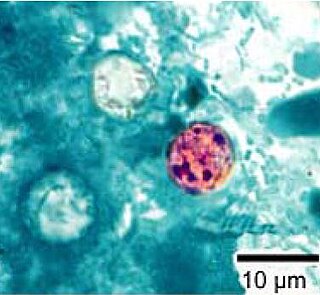Related Research Articles

Eimeria is a genus of apicomplexan parasites that includes various species capable of causing the disease coccidiosis in animals such as cattle, poultry, dogs, cats, and smaller ruminants including sheep and goats. Eimeria species are considered to be monoxenous because the life cycle is completed within a single host, and stenoxenous because they tend to be host specific, although a number of exceptions have been identified. Species of this genus infect a wide variety of hosts. Thirty-one species are known to occur in bats (Chiroptera), two in turtles, and 130 named species infect fish. Two species infect seals. Five species infect llamas and alpacas: E. alpacae, E. ivitaensis, E. lamae, E. macusaniensis, and E. punonensis. A number of species infect rodents, including E. couesii, E. kinsellai, E. palustris, E. ojastii and E. oryzomysi. Others infect poultry, rabbits and cattle. For full species list, see below.
Plasmodium kentropyxi is a parasite of the genus Plasmodium subgenus Sauramoeba.
Eimeria bufomarini is a species of coccidium, known to infect the epithelial cells of the intestines of Brazilian cane toads.

Adeleorina is a suborder of parasites in the phylum Apicomplexa.

Eimeriidae is a family of Apicomplexa. It contains the following genera:
Acroeimeria is a genus of parasites that contains those species which initially develop immediately beneath the brush-border of the intestinal epithelium, but the meronts and gamonts of which are early on extruded to form a layer on the surface of the gut mucosa. Morphologically they are similar to the Eimeria to which they are closely related. The genus was described in 1989 by Paperna and Landsberg.
Goussia is a taxonomic genus, first described in 1896 by Labbé, containing parasitic protists which largely target fish and amphibians as their hosts. Members of this genus are homoxenous and often reside in the gastrointestinal tract of the host, however others may be found in organs such as the gallbladder or liver. The genera Goussia, as current phylogenies indicate, is part of the class Conoidasida, which is a subset of the parasitic phylum Apicomplexa; features of this phylum, such as a distinct apical complex containing specialized secretory organelles, an apical polar ring, and a conoid are all present within Goussia, and assist in the mechanical invasion of host tissue. The name Goussia is derived from the French word gousse, meaning pod. This name is based on the bi-valve sporocyst morphology which some Goussians display. Of the original 8 classified Goussians, 6 fit the “pod” morphology. As of this writing, the genera consists of 59 individual species.

Cyclospora is a genus of apicomplexan parasites. It includes the species Cyclospora cayetanensis, the causative agent of cyclosporiasis. Members of Cyclospora are characterized as having oocysts with two sporocysts, each containing two sporozoites.

Hemolivia is a genus of the phylum Apicomplexia.
The genus Schellackia comprises obligate unicellular eukaryotic parasites within the phylum Apicomplexa, and infects numerous species of lizards and amphibians worldwide. Schellackia is transmitted via insect vectors, primarily mites and mosquitoes, which take up the parasite in blood meals. These vectors then subsequently infect reptilian and amphibian which consume the infected insects. The parasites deform erythrocytes of the host into crescents, and can be visualised using a blood smear.
Hoarella is a genus of parasitic alveolates in the phylum Apicomplexa. This genus infects reptiles.
Epieimeria is a genus of parasitic alveaolates of the phylum Apicomplexa.
Pythonella is a genus of parasitic alveolates belonging to the phylum Apicomplexa. This genus was created by Ray and Das-Gupta in 1937.
References
- ↑ Lainson R (2003) Some coccidial parasites of the lizard Amphisbaena alba (Reptilia: Amphisbaenia: Amphisbaenidae) Mem Inst Oswaldo Cruz, Rio de Janeiro 98(7)927-936
- ↑ Lainson R, Paperna I (1999) Some coccidia from the gall-bladder and intestine of the teiid lizard Ameiva ameiva ameiva and the gecko Hemidactylus mabouia in north Brazil. Parasite 6(2):151-162
- ↑ Sloboda M, Modrý D (2006) New species of Choleoeimeria (Apicomplexa: Eimeriidae) from the veiled chameleon, Chamaeleo calyptratus (Sauria: Chamaeleonidae), with taxonomic revision of eimerian coccidia from chameleons. Folia Parasitol (Praha) 53(2):91-97
- ↑ Paperna I, Lainson R (2000) Ultrastructural study of meronts and gamonts of Choleoeimeria rochalimai (Apicomplexa: Eimeriidae) developing in the gall bladder of the gecko Hemidactylus mabouia from Brazil. Folia Parasitol (Praha) 47(2):91-96
- ↑ Modrý D, Jirků M (2006) Three new species of coccidia (Apicomplexa: Eimeriorina) from the Marble-throated skink, Marmorosphax tricolor Bavay, 1869 (Reptilia: Scincidae), endemic to New Caledonia with a taxonomic revision of Eimeria spp. from scincid hosts. Parasitol. Res. 99(4):419-428
| | This Apicomplexa-related article is a stub. You can help Wikipedia by expanding it. |